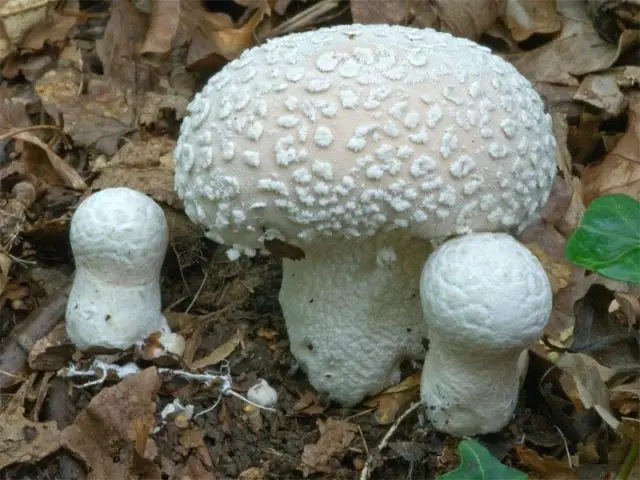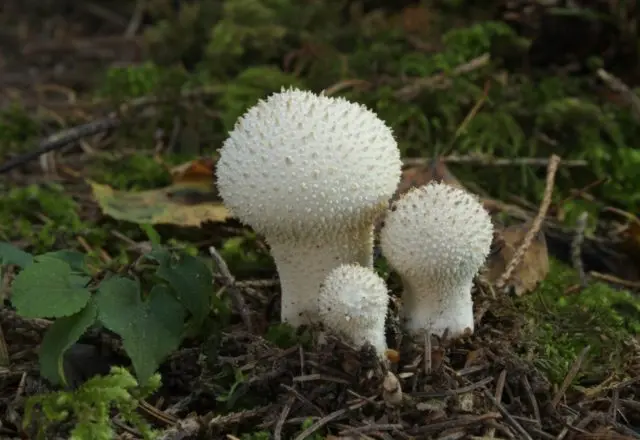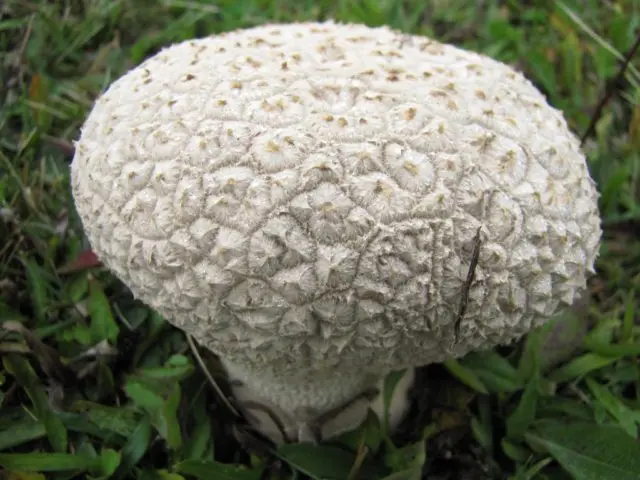Contents
Ragged raincoat (lat. Lycoperdon mammiforme or Lycoperdon velatum) is a rather rare species, which is considered one of the most beautiful representatives of the Champignon family. The name of the mushroom was based on the peculiarity of the structure of the hat, which makes it easy to distinguish it from other varieties of raincoats.
Description of the ragged raincoat
The shape of the fruiting body resembles an inverted pear, especially in young specimens. As it matures, the cap expands and takes on a flattened appearance.
The diameter of the fungus can reach 4-5 cm, height – 6 cm. At the initial stage of development, the skin is relatively smooth, covered with large furrows. Over time, its top layer is torn, so the hats of adult ragged raincoats are covered with large white flakes, as can be seen in the photo below. As a rule, they are lighter than the rest of the fungus, which by this time darkens slightly and acquires a beige or ocher color. At the base of the leg, the outer cover remains for quite a long time, which is why a kind of collar usually forms under the hat, the edges of which are bent down.
The flesh on the cut is white, but only in young specimens. In mature mushrooms, it darkens and becomes a chocolate shade.

The hat of a ripe ragged raincoat is covered with uneven white flakes.
Twins and their differences
There are few twins in the ragged raincoat, since the unusual appearance helps to easily distinguish it from false members of the family. On the other hand, inexperienced mushroom pickers can still mistakenly collect, instead of it, a related subspecies – an edible raincoat (lat. Lycoperdon perlatum) or prickly.
In young mushrooms, the surface of the cap is warty, with each tubercle having a conical shape. Because of this, it seems that the hat is as if studded with small spikes. They are absent in old specimens, therefore, according to the general silhouette, they can be confused with a ragged raincoat. But the latter’s skin is never smooth, its cap is covered with large flakes. In young mushrooms, distinct cracks are present on the surface, which is not observed in the twin.
As the name implies, edible raincoat can be eaten, but it is desirable to collect white fruiting bodies – their flesh is elastic and tasty. The dark hat indicates the old age of the fungus.
This species bears fruit from June to October-November. It can be found in both coniferous and deciduous forests.

On the surface of the cap, the edible raincoat has many small spines.
Baggy golovach (lat. Bovistella utriformis) or bubble golovach is another twin. They can be distinguished, first of all, by size – a similar variety is much larger than a ragged raincoat. The height of the baggy golovach can reach 10-15 cm, some specimens even grow up to 20 cm. For this reason, different species can only be confused at a young age.
Another difference between them is the structure of the cap. In a ragged raincoat, it is covered with torn flakes, which are located on the surface not too close to each other. The baggy golovach has a tuberculate hat – the skin is represented by convex warty formations that are adjacent to each other.
The double bears fruit from the last days of May to mid-September, while the peak of ripening occurs in July. You can find it on forest edges and meadows, most often singly.

There are no significant gaps between warty formations
Where and how to grow
Puffball prefers deciduous forests and grows mainly under oak or hornbeam. Most often, it bears fruit in small groups, but single specimens can also be found. The distribution area includes areas with a mild warm climate. In Our Country, this species can be found within the middle lane.
The fruiting season is from July to October, but sometimes it stretches into November if the year is warm.
Like other mushrooms, tufted raincoat quickly absorbs toxic substances from the soil. For this reason, it is better not to collect old fruiting bodies, especially if they grow near roads. Their pulp accumulates a large amount of heavy metals.
Is the tufted raincoat mushroom edible or not
The ragged raincoat is classified as an edible variety, but only young mushrooms are recommended to be eaten. These include specimens that have not yet formed spores – their flesh is soft, tender and juicy.
They prepare a ragged raincoat in different ways, but most often the fruiting bodies are finely chopped and fried in a pan or grill – they perfectly tolerate heat treatment. The pulp at the same time does not soften to a jelly-like state and does not fall apart. During cooking, the caps and legs do not decrease in size.
For the winter, the crop is usually dried, but raincoats can also be pickled.
Useful properties of ragged raincoats
The benefits of the ragged raincoat have long been known – for several centuries, patients in European countries have been fed broth from the pulp of this mushroom. The beneficial effect on the human body is explained by the fact that the fruiting bodies of this species quickly absorb heavy metals and slags. That is why dishes from it are recommended for use by people with kidney and liver diseases. In addition, the ragged compounds contained in the raincoat strengthen the human immune system and reduce the risk of developing cardiovascular diseases.
Conclusion
Ragged raincoat is an edible mushroom that does not have poisonous counterparts, so you can collect it without much fear. All species similar to it are suitable for consumption, therefore, even in the event of an error, there will be no harm from the harvested crop. At the same time, it is desirable to give preference to young specimens, since in overripe mushrooms the flesh acquires an unpleasant aftertaste. In addition, old fruiting bodies contain a large amount of harmful substances, which they draw from the soil as they develop.
You can learn more about what a ragged raincoat looks like in the video below:









